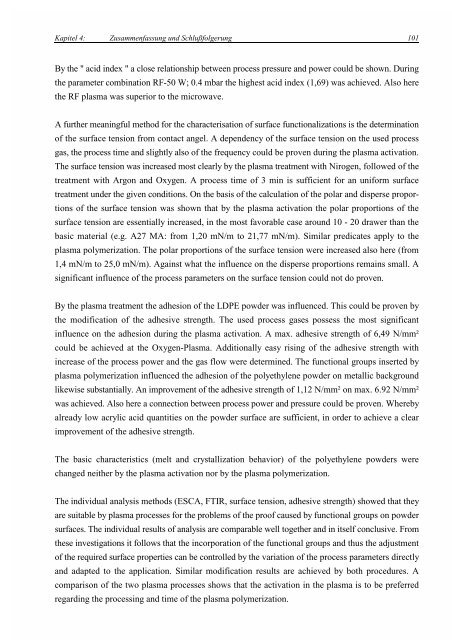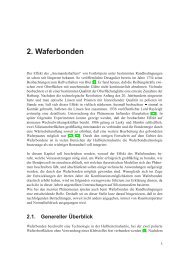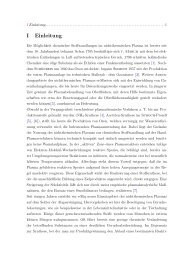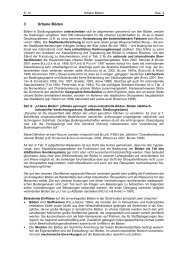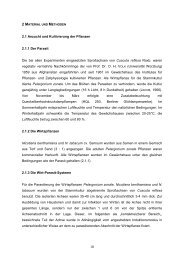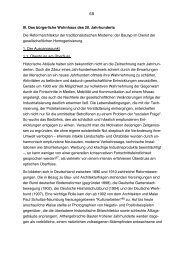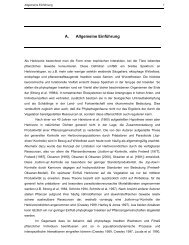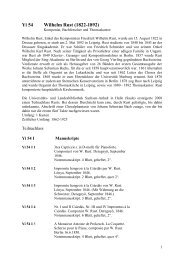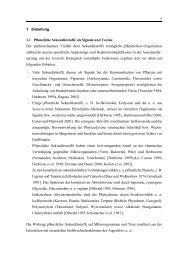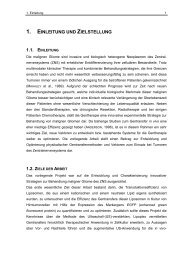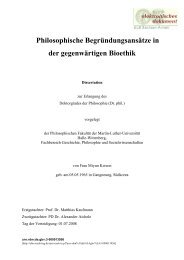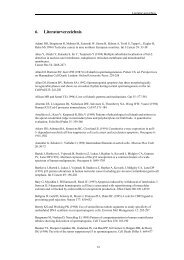“plasmamodifizierung von polyethylen” dissertation zur erlangung ...
“plasmamodifizierung von polyethylen” dissertation zur erlangung ...
“plasmamodifizierung von polyethylen” dissertation zur erlangung ...
Sie wollen auch ein ePaper? Erhöhen Sie die Reichweite Ihrer Titel.
YUMPU macht aus Druck-PDFs automatisch weboptimierte ePaper, die Google liebt.
Kapitel 4: Zusammenfassung und Schlußfolgerung 101<br />
By the " acid index " a close relationship between process pressure and power could be shown. During<br />
the parameter combination RF-50 W; 0.4 mbar the highest acid index (1,69) was achieved. Also here<br />
the RF plasma was superior to the microwave.<br />
A further meaningful method for the characterisation of surface functionalizations is the determination<br />
of the surface tension from contact angel. A dependency of the surface tension on the used process<br />
gas, the process time and slightly also of the frequency could be proven during the plasma activation.<br />
The surface tension was increased most clearly by the plasma treatment with Nirogen, followed of the<br />
treatment with Argon and Oxygen. A process time of 3 min is sufficient for an uniform surface<br />
treatment under the given conditions. On the basis of the calculation of the polar and disperse proportions<br />
of the surface tension was shown that by the plasma activation the polar proportions of the<br />
surface tension are essentially increased, in the most favorable case around 10 - 20 drawer than the<br />
basic material (e.g. A27 MA: from 1,20 mN/m to 21,77 mN/m). Similar predicates apply to the<br />
plasma polymerization. The polar proportions of the surface tension were increased also here (from<br />
1,4 mN/m to 25,0 mN/m). Against what the influence on the disperse proportions remains small. A<br />
significant influence of the process parameters on the surface tension could not do proven.<br />
By the plasma treatment the adhesion of the LDPE powder was influenced. This could be proven by<br />
the modification of the adhesive strength. The used process gases possess the most significant<br />
influence on the adhesion during the plasma activation. A max. adhesive strength of 6,49 N/mm²<br />
could be achieved at the Oxygen-Plasma. Additionally easy rising of the adhesive strength with<br />
increase of the process power and the gas flow were determined. The functional groups inserted by<br />
plasma polymerization influenced the adhesion of the polyethylene powder on metallic background<br />
likewise substantially. An improvement of the adhesive strength of 1,12 N/mm² on max. 6.92 N/mm²<br />
was achieved. Also here a connection between process power and pressure could be proven. Whereby<br />
already low acrylic acid quantities on the powder surface are sufficient, in order to achieve a clear<br />
improvement of the adhesive strength.<br />
The basic characteristics (melt and crystallization behavior) of the polyethylene powders were<br />
changed neither by the plasma activation nor by the plasma polymerization.<br />
The individual analysis methods (ESCA, FTIR, surface tension, adhesive strength) showed that they<br />
are suitable by plasma processes for the problems of the proof caused by functional groups on powder<br />
surfaces. The individual results of analysis are comparable well together and in itself conclusive. From<br />
these investigations it follows that the incorporation of the functional groups and thus the adjustment<br />
of the required surface properties can be controlled by the variation of the process parameters directly<br />
and adapted to the application. Similar modification results are achieved by both procedures. A<br />
comparison of the two plasma processes shows that the activation in the plasma is to be preferred<br />
regarding the processing and time of the plasma polymerization.


